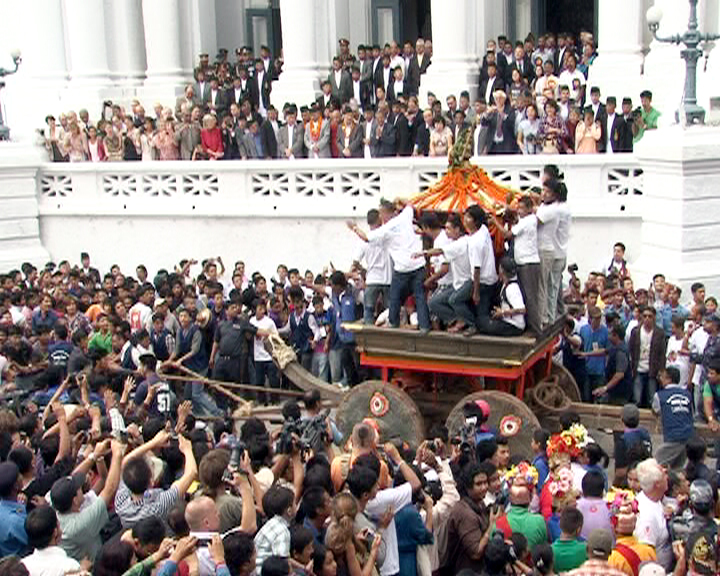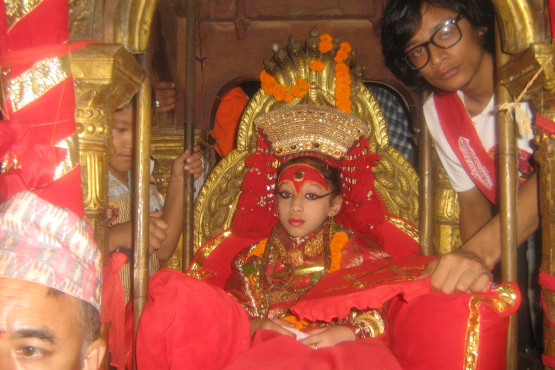- HOME
- Destination
- Adventure Activities
- About Us
- BLOGS
- CONTACT US

Being a multi-religious country, Nepal celebrates many festivals throughout the year which are of the different essence. A multi-religion country followed by various ethnicity, the festivals in Nepal complies an amazing list. Nepal celebrates festivals which cherishes the relation with brother and sister, husband and wife, animals and human being and there are festivals which are celebrated remembering the deceased ones.
Indra Jatra is the festival which is celebrated mainly inside the Kathmandu valley remembering the deceased member of the family from the past year. There is also various significance regarding why the festival is celebrated.
Indra Jatra, also known as Yenya is the biggest religious street festival which is celebrated in Kathmandu. The word “Yenya” consists of two words, “Ye” and “Ya,” which means Kathmandu and celebration, and together it means “celebration inside Kathmandu.” The celebration of the festival consists of two main events, one being Indra Jatra and another is Kumari Jatra. It was started by King Gunakamadeva to celebrate the founding of the Kathmandu city in the 10th century.
Indra Jatra is an eight-day festival, which starts from the 12th day of the bright fortnight to the 4th day of the dark fortnight of Yanla, the eleventh month in the lunar Nepal Era calendar. However, the Kumari Jatra began only from the mid of 18th century.
Although the celebration of Indra Jatra started in the 10th century, this festival has several importance. One of them being as a festival to remember the deceased family member from the past year. People also impersonate several gods and goddess by wearing the costumes and does act through dancing in the street implying different meaning.
Looking at the legend, there is saying that Lord Indra, who is the Hindu God as well as King of heaven once came on earth disguising himself as a farmer. He came in search of a flower parijat (night jasmine) for his mother Basundhara to perform a ritual. But he was seen and caught by the people, while he was plucking the flowers at Maruhiti, a sunken spout at Maru. The people took him as a common thief and put him on display in the town square of Maru in Kathmandu. (In Jatra, this event is reenacted by an image of Indra with his hands bound in display at Maru and other places in the festival.)
Indra’s mother got worried due to his long absence, so she came to Kathmandu as well and wandered around looking for his son. (In Jatra, this event is commemorated by the procession of Dagin through the city. Also, Pulukisi/Tanakisi, an impersonation of an elephant also runs around the town in search of his master.)
After the people realized that they had captured Lord Indra himself, they immediately released him. Indra’s mother became grateful to the villagers for releasing her son, and she promised to provide enough dew throughout the winter for the rich crop. There is a belief that Kathmandu started to experience foggy morning from this festival onwards because of this boon.

Masked Dance during Indra Jatra
Indra Jatra starts from the erection of a pole: the pole is known as Yosin Thanegu. From that pole, the banner of Indra is unfurled at the Kathmandu Durbar Square. The pole is a tree shorn of its branches, stripped of its bark and is from a forest near Nala. Nala is a small town situated at the east of Kathmandu. The pole is dragged in stages to Durbar Square by men pulling on ropes.
In the first day of celebration, another event takes place as well. The event is known as Upaku Wangeu, when the people visiting shrines hold lighted incensed to honor the deceased family members. With candles, people also place small butter lamps on the way. They also sing hymns while making the tour. Throughout the festival several procession takes places. Let us take a look at them:
Kumari Jatra was started during the reign of Jaya Prakash Malla in 1756 AD. Kumari Jatra means the chariot festival of Kumari. This festival is celebrated by pulling the three chariots, carrying a human representation of deities Ganesh, Bhairava and Kumari. All the three chariots are accompanied by a musical band which is pulled along the festival route through Kathmandu on three days.
The first day of Kumari Jatra is known as Kwaneya when the chariots are pulled through the southern part of town. On the second day, which is a full moon day and is also known as Yenya Punhi, the chariots are drawn through the northern part till Asan. And, on the third day of Nanichaya, the procession is passed through the central section at Kilagal. It has been on a custom that since 2012, the chariot of Kumari is pulled by all women team on the third day.

Kumari Chariot during Indra Jatra
Mata Biye another procession of Indra Jatra. The meaning of Mata Biye means to offer butter lamps. During the first day of chariot festival, Kwaneya, the Newars honors their deceased family members in past year by offering small butter lamps along the processional route.
During the procession of Goddess Dagin, there is a reenactment of Indra’s mother going around the town searching for her son. The procession consists of men wearing a mask along a musical band. Dagin procession starts when the chariot of Kumari returns to Maru after journeying around the southern part of the town.
It starts from an alley at the south-western corner of Maru square and passes by the western side of Kasthamandap continuing to the southern end of town before returning to Maru. The participants of this festival follow the festival route.
This procession of Indra Jatra consists of a long representation of a holy snake made of reed on which a row of oil lamps are placed. The effigy is suspended from poles and carried on the shoulders taking along the festival route. Bau Mata procession starts when the Dagin procession returns from the upper part of the town and reaches Maru.
Several masked dance and exhibitions in Indra Jatra excite the celebration of the festival. You can see masks of Bhairva, a terrifying aspect of Lord Shiva on display in the many places in Kathmandu throughout the eight days of the festival. There is a mask of Aakash Bhairavam, images of Indraraj Dyah, incarnations of Lord Vishnu and mask of other deities.
There are several types of masked dances which are very interesting and fun to watch. Pulu Kisi dance is also known as elephant dance, where Pulukisi goes through the streets searching his master (Indra) and knocks anyone that comes in path while amazingly swinging its tail.
Majipa Lakhey is a demon dance performed on the streets and market squares. Sawa Bhakku is a group dance which consists Bhairava and his two attendants. In Devi Pykhan, dancers wear masks of various gods and goddess and perform at Kilagal, Hanuman Dhoka, Jaisidewal, Bangemuda, and Indra Chowk. Mahakali Pykhan features dancers dressed in costumes representing Khyah, a fat, hairy ape-like creature.
This year Indra Jatra is celebrated from 21st September to 29 September. However, 24th September is the main day of attraction.
Your email address will not be published.Required fields are marked *
You must be logged in to post a comment.
0 Comments on "Indra Jatra: Remembering the Deceased"